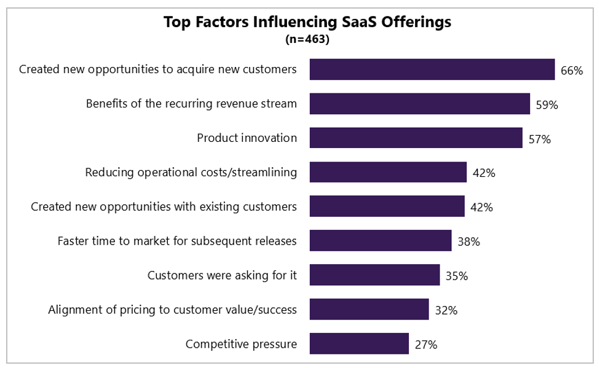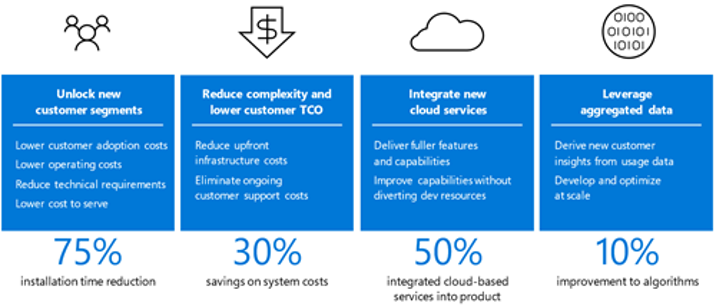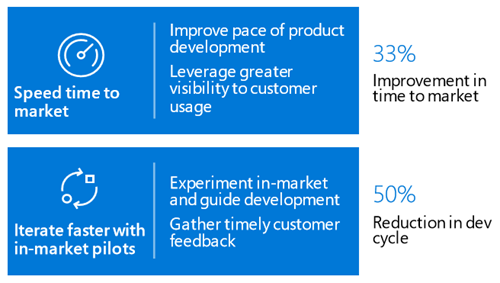Back in the day you bought a disk with software and when you wanted to use it you would install it on your computer. However you could only use the software on that specific computer. With SaaS, you can relieve your customers from many of these costs by taking on the responsibility for hosting software. A well known example of a SaaS solution is Office 365.
The evolution of SaaS, driven by advancements in cloud technology, has fundamentally changed the software industry, and how it operates. But why do so many software companies transfer to SaaS? And what impact does this have on the business process of the ISV?
Why do companies choose a SaaS solution?
MDC Research survey participants have provided a list of the top factors influencing their decision to create a SaaS offering, which you can consider as you evaluate creating your own SaaS practice. 66% of the ISV’s named creating new opportunities to acquire new customers as the main reason. 59% of the respondents named the benefits of the recurring revenue stream has impacted their decision. Product innovatios are also named as 3rd in the list of factors that influence this decision.


(Source: Microsoft ISV Research, February 2018)
Key benefits of the SaaS model
The SaaS model allows you to deliver a better experience to a broader range of customers. According to a research, ISVs who developed a SaaS version of their software were able to unlock new customer segments and deliver significant additional value to their customers, including reduced complexity and lower TCO, expanded service offerings through the integration of new cloud services, improved analytics and business intelligence gained by leveraging aggregated data, shortened shipment cycles for updates and new features, and ease of maintenance and change management (Keystone, 2017).


(Source: Keystone research, June 2017)
Unlock new customer segments
Among MDC Research survey participants, 66% cited creating new opportunities to acquire new customers as the top factor in their decision to create a new SaaS offering. With SaaS, you can sell to a broader customer base, adding customer segments that were previously unprofitable, due to the lower cost to serve and reduced technical requirements enabled by operating SaaS on public cloud platforms. Adopting a SaaS model that runs on the public cloud also eliminates many barriers to geographic expansion. In a traditional model, expanding geographically often requires setting up local partnerships or sending a team of support engineers to client sites around the world, options that are expensive and time consuming. By running your software on the public cloud, however, you can take advantage of your cloud provider’s global infrastructure and support to offer higher performance and lower latency for end users. This global infrastructure can support local data residency, sovereignty, and compliance requirements, as well.
75% installation time reduction!
Reduce complexity and lower customer TCO
One of the single biggest benefits of shifting to SaaS delivery is that customer hardware and infrastructure can be moved into a single, unified infrastructure for application deployment. In most cases, the SaaS delivery model results in the realization of significant savings for your customers, due to the reduction in the complexity and cost of underlying infrastructure. On premises applications often require customers to invest in a considerable amount of infrastructure to host software. Depending on the size of the company and the performance level of the application, these costs can easily spiral into the millions of dollars. The customer must continually invest in ongoing maintenance and support for these assets. With SaaS, you can free your customers from many of these costs by taking on the responsibility for hosting software through Microsoft or a PaaS/IaaS third-party partner. And, the benefits of a single application deployment environment are not just for customers. A unified environment allows your development teams to focus more on high-value product feature development, and less on maintaining system infrastructure.
30% savings on system costs
Integrate new cloud services
The integration of value-added cloud services allows you to improve your service offering by providing capabilities that previously would have been time and cost intensive to develop independently. Many of these services are available through the cloud platform ecosystem with minimal integration and support requirements. Nearly half of the companies surveyed reported integrating richer feature sets and capabilities into their SaaS product. Based on customer demand, advanced data analytics, business intelligence, visualization and collaboration tools were among the top capabilities companies added as they moved their software to the cloud. These services were incorporated either by integrating first-party services offered by Microsoft Azure and other cloud providers, or by partnering with another SaaS company.
Leverage aggregated data
Cloud ecosystems facilitate easier collection of customer usage data, providing you with more detailed insights into customer needs and pain points. Insights generated through application data collection enable you to focus product development efforts on the features most important to your customers, and to deliver those features faster. Keystone survey participants reported increasing the speed of product development by 33%, contributing to a 50% reduction in their development cycles.


(Source: Keystone research, June 2017)
By aggregating data collected across customers, you can also perform benchmarking and analysis for conducting rapid improvement of products and algorithms. Aggregating data across SaaS customers can help you to identify inefficiencies in the customer experience, causes of customer churn, and unmet needs. Perhaps more importantly, these aggregated customer data sets allow you to develop and optimize your algorithms at scale. Where you might not have access to this data in an onpremises model, a SaaS model provides for these types of scale effects.
Improve financial predictability
One of the primary business benefits you will realize by switching to SaaS is a smoothing out of monthly recurring revenue streams. With a SaaS business model, customers typically pay recurring (monthly or annual) fees to access products, so as your customers are shifted to SaaS subscription or consumption plans from traditional licensing models, you will see your proportion of recurring revenue grow, increasing the confidence and reliability of financial performance.
The flexibility of SaaS pricing models allow pricing to be tailored to customer needs, allowing revenue generation to be more closely tied to usage and increasing the value you can capture across your customer base.
Conclusion
Whether you are a cloud-native start-up or an existing ISV with legacy on-premises software solutions, SaaS represents an opportunity to deliver more value to your customers, while simultaneously increasing profitability and improving internal operations through reduced cost and complexity. Who doesn’t want this?
We help a lot of companies with the transformation to a SaaS solution. Are you curious how we do this? Contact us!


